10 Stunning Decorative Vegetable Garden Ideas for Both Beauty and Bounty
1. Rainbow Swiss Chard Borders
Create vibrant garden borders using rainbow Swiss chard with its striking red, yellow, and pink stems. Plant these colorful veggies along pathways or to frame garden beds for an instant splash of color that’s both ornamental and edible. The large, textured leaves add visual interest while providing nutritious greens for your kitchen.
2. Spiral Herb Gardens
Design a spiral-shaped herb garden that adds vertical interest while maximizing growing space. Build it using stones or bricks in a gradually ascending spiral, creating different microclimates for various herbs. Place drought-tolerant herbs like rosemary and thyme at the top and moisture-loving varieties like mint and parsley at the bottom for a functional and eye-catching focal point.
3. Vegetable Tepees and Trellises
Construct decorative tepees or trellises using bamboo poles or branches for climbing vegetables like beans, peas, and cucumbers. These vertical structures save space and create dramatic height in your garden. Paint or decorate the supports with weather-resistant materials to enhance their visual appeal when the plants are still young.
4. Keyhole Garden Beds
Incorporate keyhole-shaped raised beds that combine accessibility with water efficiency. These circular beds feature a central compost area with a narrow access path, resembling a keyhole from above. The unique shape allows you to reach all plants without stepping on soil while adding distinct visual geometry to your garden design.
5. Edible Flower Integration
Intersperse edible flowers like nasturtiums, calendula, and borage throughout vegetable beds for pops of color and culinary uses. These blooms attract beneficial insects while adding unexpected beauty to utilitarian spaces. Their edible petals can garnish salads and desserts, bringing your garden directly to your table.
6. Geometric Pattern Planting
Arrange vegetables in striking geometric patterns like checkerboards, concentric circles, or diagonal stripes based on foliage color and texture. Alternate purple cabbage with silvery kale or contrast feathery carrot tops with broad squash leaves for visual interest. This method transforms ordinary vegetable beds into living works of art.
7. Potager Garden Design
Create a French-inspired potager garden that blends vegetables, herbs, and flowers in an organized but artistic layout. Design symmetrical beds separated by gravel paths with a central focal point like a small fountain or decorative obelisk. This centuries-old approach prioritizes both aesthetics and function for a truly sophisticated kitchen garden.
8. Living Wall Vegetable Gardens
Install vertical growing systems on walls or fences to cultivate leafy greens, herbs, and compact vegetables in limited spaces. Use hanging planters, pocket systems, or custom-built frames to create a stunning living tapestry of edibles. These space-saving gardens make dramatic visual statements while producing abundant harvests.
9. Companion Planting Clusters
Group plants in attractive clusters based on companion planting principles, combining vegetables with beneficial flowers and herbs. Plant purple basil alongside tomatoes or surround cabbage with aromatic herbs to deter pests naturally. These thoughtful combinations improve plant health while creating visually pleasing arrangements.
10. Decorative Container Gardens
Arrange vegetables in unexpected containers like vintage wheelbarrows, wooden barrels, or colorful ceramic pots for instant charm. Group containers of varying heights to create vertical interest and mobility. This approach works particularly well for small spaces like patios and balconies, proving that productive gardens can thrive anywhere.
Creating Elevated Garden Beds for Visual Impact and Accessibility
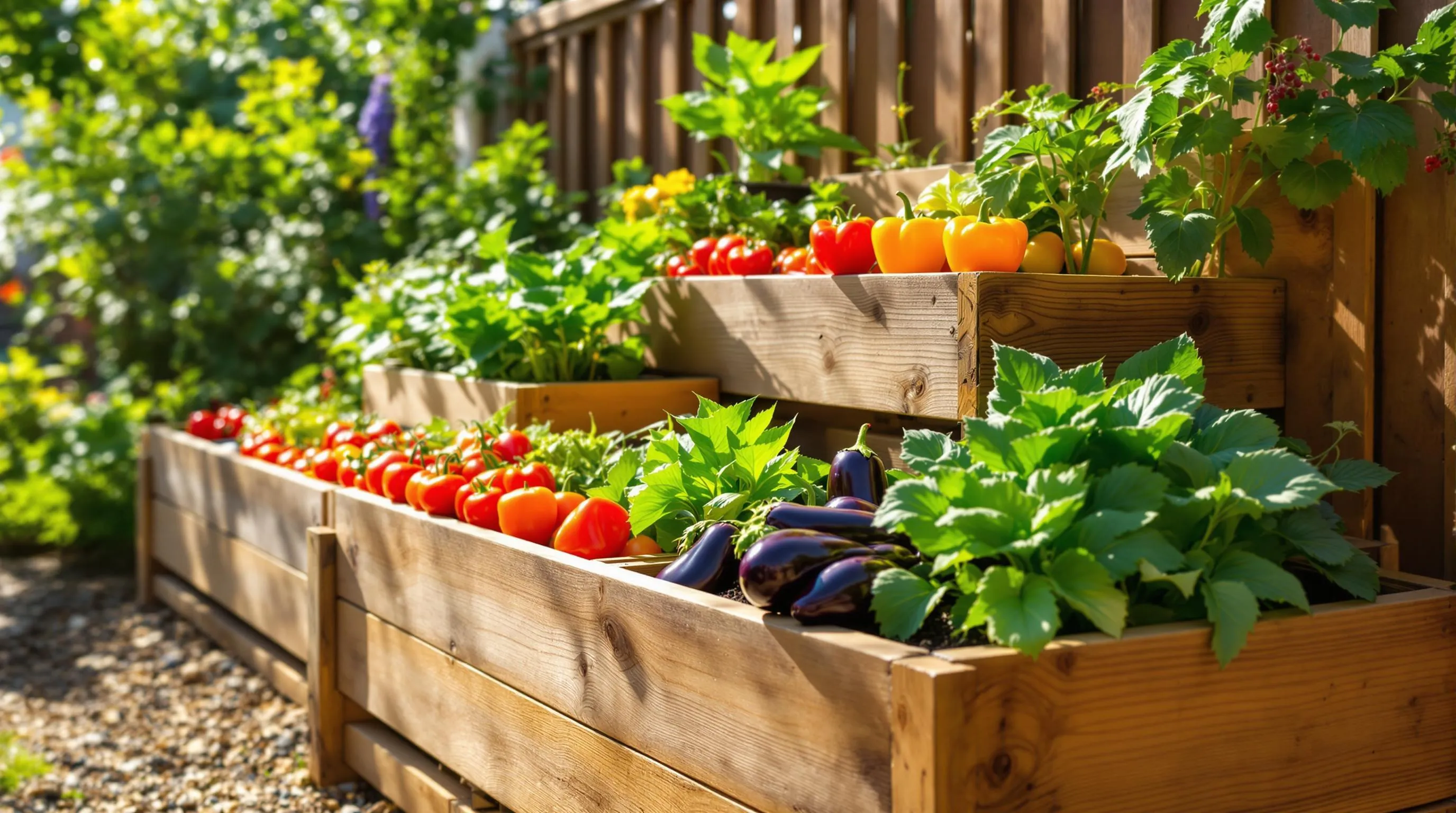
Elevated garden beds elevate both your planting space and your garden’s visual appeal, offering practical benefits alongside stunning aesthetics. These structures lift your vegetables to a more accessible height, reducing back strain while creating architectural interest in your industry.
Tiered Wooden Raised Beds for Dramatic Effect
Tiered wooden raised beds transform flat garden spaces into multi-dimensional landscapes that draw the eye upward. Build these stepped structures using cedar, redwood, or pressure-treated lumber to create dramatic levels that showcase different vegetables at varying heights. Position taller plants like tomatoes and peppers on the highest tier, mid-height plants like eggplants and cabbage in the middle, and trailing crops such as strawberries along the lower edges where they can cascade down. This arrangement not only creates visual interest but also improves air circulation and makes harvesting easier. For additional impact, install solar-powered string lights along the edges of each tier to illuminate your garden at night.
Metal-Framed Raised Gardens with Industrial Charm
Metal-framed raised beds bring contemporary industrial style to your vegetable garden while offering exceptional durability. Opt for weathered Cor-Ten steel that develops a rich, rust-colored patina or galvanized metal frames for a sleek silver finish that complements modern home exteriors. These metal structures create striking geometric shapes in your industry and can be customized to various heights—from knee-level for root vegetables to waist-high for herbs and leafy greens. The metal conducts heat efficiently, warming soil earlier in spring and extending your growing season. Pair these industrial elements with softening touches like cascading nasturtiums or thyme spilling over the edges to balance the hard lines with organic forms.
Incorporating Trellises and Vertical Growing Structures
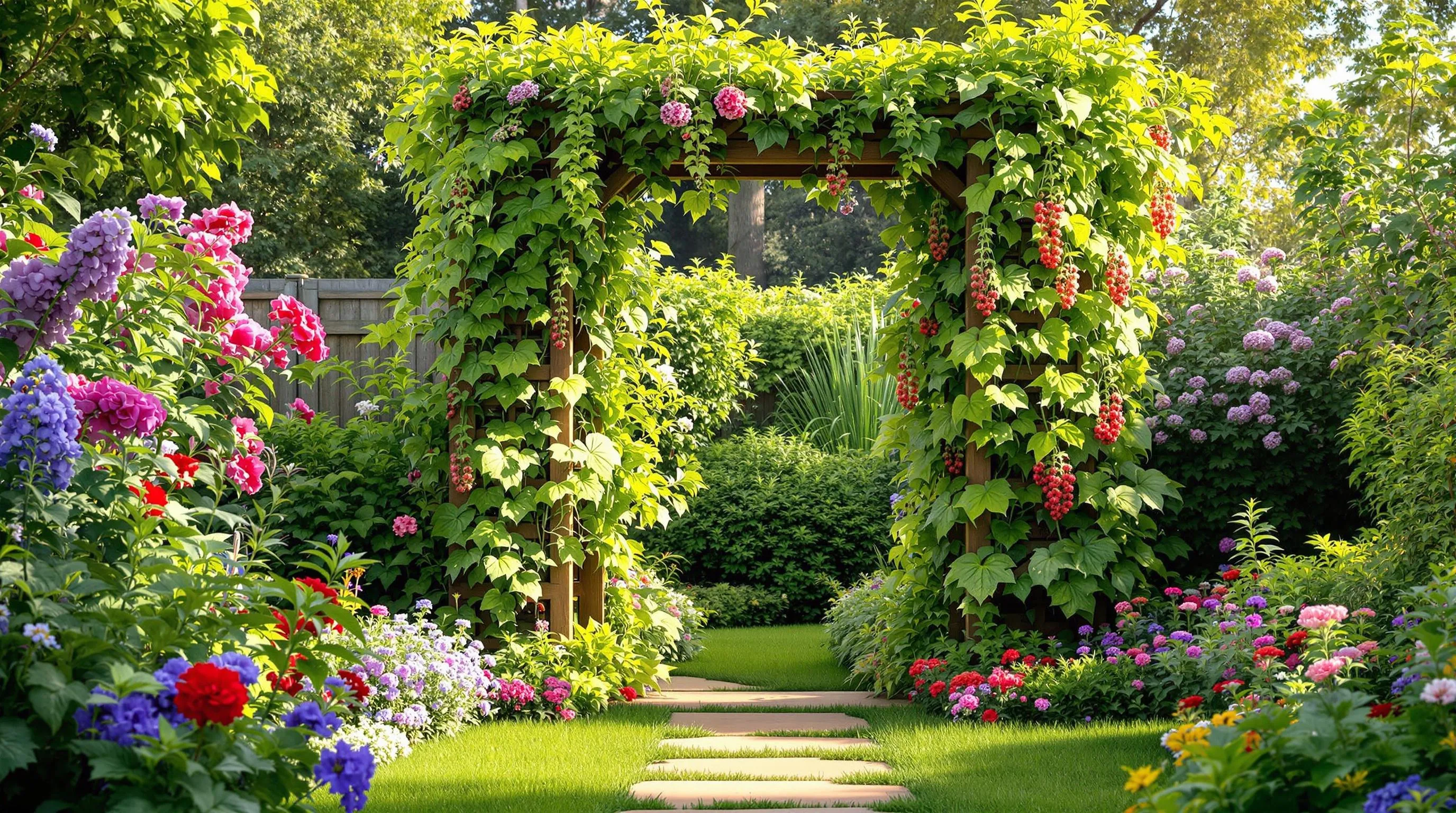
Vertical growing structures transform your vegetable garden by maximizing space while creating stunning visual interest. Trellises, arches, and wall systems add architectural elements that elevate your garden’s aesthetic appeal while supporting climbing vegetables like peas, beans, cucumbers, and small melons.
Decorative Arches for Climbing Vegetables
Garden arches serve as beautiful focal points while providing essential support for climbing vegetables. Install wrought iron, wooden, or metal arches along pathways to create enchanting garden entrances draped with scarlet runner beans, purple hyacinth beans, or colorful sweet peas. Position these structures strategically to frame garden views or connect different garden sections. For added charm, place potted herbs or flowers at the base of each arch. These functional sculptures not only make harvesting easier by bringing vegetables to eye level but also cast interesting shadow patterns across your garden throughout the day.
Living Wall Systems for Small Spaces
Living walls transform limited garden areas into productive vertical vegetable gardens that double as living art installations. Install pocket planters, modular panels, or guttering systems on sunny walls or fences to grow compact vegetables like lettuce, herbs, strawberries, and bush tomatoes. These space-saving answers capture attention while providing excellent drainage and air circulation for healthier plants. For a polished look, arrange plants in patterns based on leaf color and texture—mixing silver sage with vibrant lettuces or cascading thyme with upright chives. Add a simple irrigation system with a timer to ensure consistent watering for your vertical vegetable display without daily maintenance.
Mixing Ornamental Plants with Edibles for Color Contrast
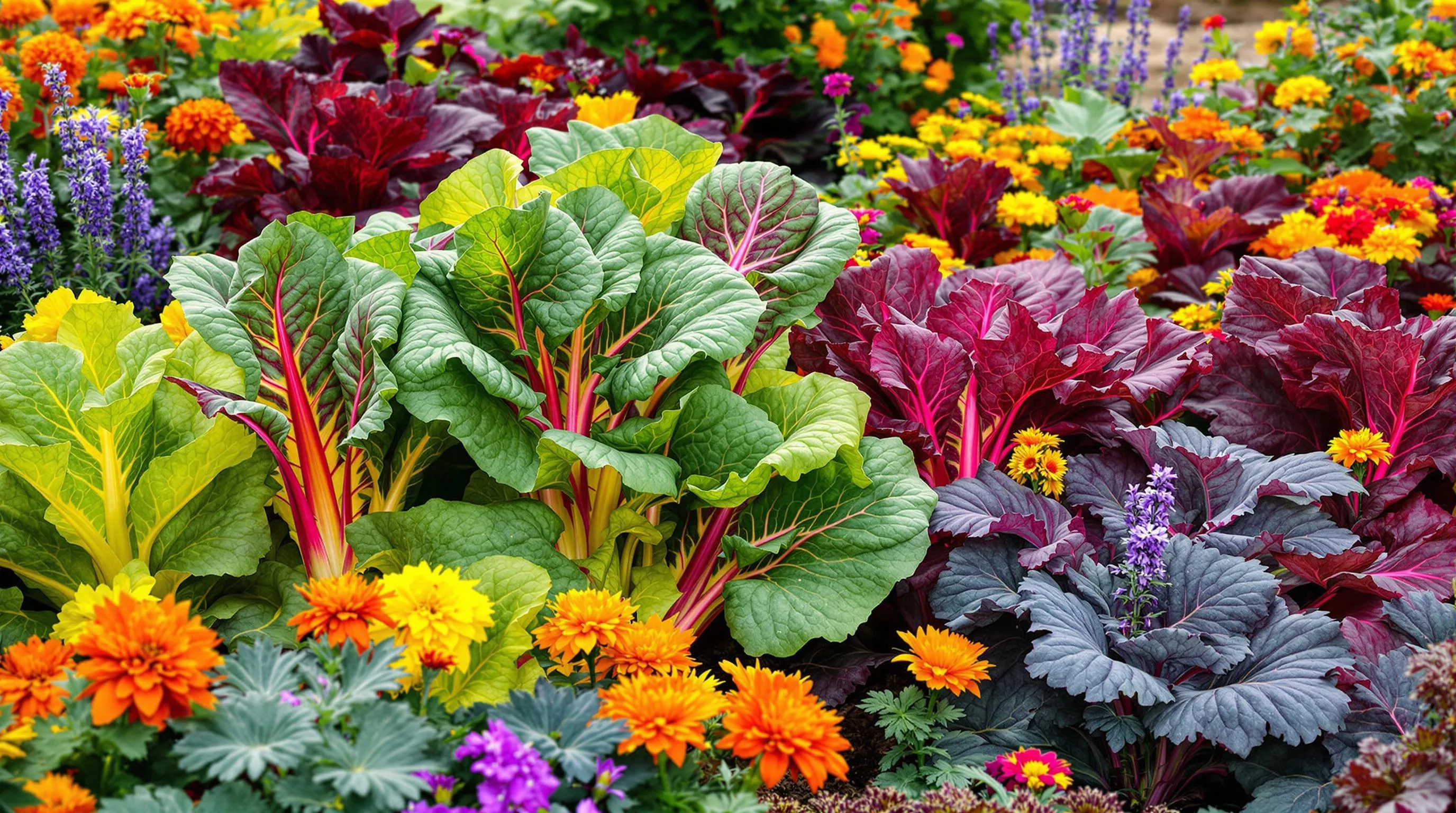
Combining ornamental plants with vegetables creates stunning visual interest while maximizing your garden’s productivity. This design approach transforms utilitarian vegetable patches into beautiful industry features through strategic color combinations and textural contrasts.
Companion Flowers That Enhance Vegetable Growth
Integrate flowers that pull double duty by attracting beneficial insects while adding vibrant colors to your vegetable garden. Marigolds deter nematodes and their bright orange and yellow blooms create striking contrasts against green vegetables. Nasturtiums offer edible flowers and leaves with a peppery flavor while repelling aphids and cucumber beetles. Plant lavender near cabbage family crops to confuse cabbage moths with its strong scent while providing purple spikes of color. Borage’s star-shaped blue flowers attract pollinators to boost tomato yields, while calendula’s golden blooms deter asparagus beetles and add cheerful splashes of color. These companion flowers not only beautify your garden but also naturally protect your vegetables, reducing the need for chemical interventions.
Using Colorful Swiss Chard and Purple Kale as Focal Points
Transform ordinary vegetable beds into extraordinary visual displays by incorporating vegetables with inherent ornamental value. ‘Bright Lights’ Swiss chard features stems in vibrant gold, pink, orange, and crimson that create instant focal points when planted in clusters. Purple kale varieties like ‘Redbor’ and ‘Scarlet’ provide rich burgundy foliage that contrasts beautifully with green vegetables and flowering plants. Position these colorful vegetables strategically—use them as border plants, center specimens in circular beds, or create repeating patterns throughout your garden. For maximum impact, plant them where afternoon sun backlights their stems, creating a stained-glass effect that elevates your vegetable garden to living artwork. These edibles maintain their ornamental value throughout the growing season while providing nutritious harvests.
Designing Geometric Patterns in Your Vegetable Plot

Geometric patterns transform ordinary vegetable gardens into visually stunning displays that captivate the eye while maintaining productivity. By incorporating deliberate shapes and symmetry into your planting scheme, you’ll create a garden that’s as beautiful as it is bountiful.
French Potager-Style Gardens with Symmetrical Layouts
The classic French potager garden combines beauty and utility through meticulous geometric planning. Start by dividing your plot into equal quadrants with intersecting pathways that create a cross pattern. Border each section with low-growing herbs like thyme or compact lavender to define the edges. Within each quadrant, arrange vegetables in tidy rows or concentric squares, alternating leaf textures and colors for visual interest. Incorporate small hedges of rosemary or boxwood to enhance the formal structure. For authentic French charm, place a decorative element like a sundial or birdbath at the center crossing point. This symmetrical approach not only looks elegant but also makes maintenance and harvesting more efficient by creating clear access to all plants.
Mandala Vegetable Gardens for Spiritual Appeal
Mandala gardens merge artistic expression with functional growing space through circular designs that radiate from a central point. Begin by marking a perfect circle for your garden bed, then divide it into pie-shaped sections using stones, bricks, or mulched pathways. Plant taller crops like corn or sunflowers at the center, then work outward with progressively shorter plants in concentric rings. Choose vegetables with complementary colors and textures to create a living mosaic—purple cabbage beside golden calendula or ferny carrot tops against bold rainbow chard. The mandala pattern naturally creates microclimates, with the inner circle offering protection for delicate plants while outer rings catch maximum sunlight. Beyond their visual impact, these circular gardens hold spiritual significance for many gardeners, promoting mindfulness as you tend to each carefully positioned plant in this sacred geometry-inspired space.
Adding Decorative Pathways Between Garden Sections
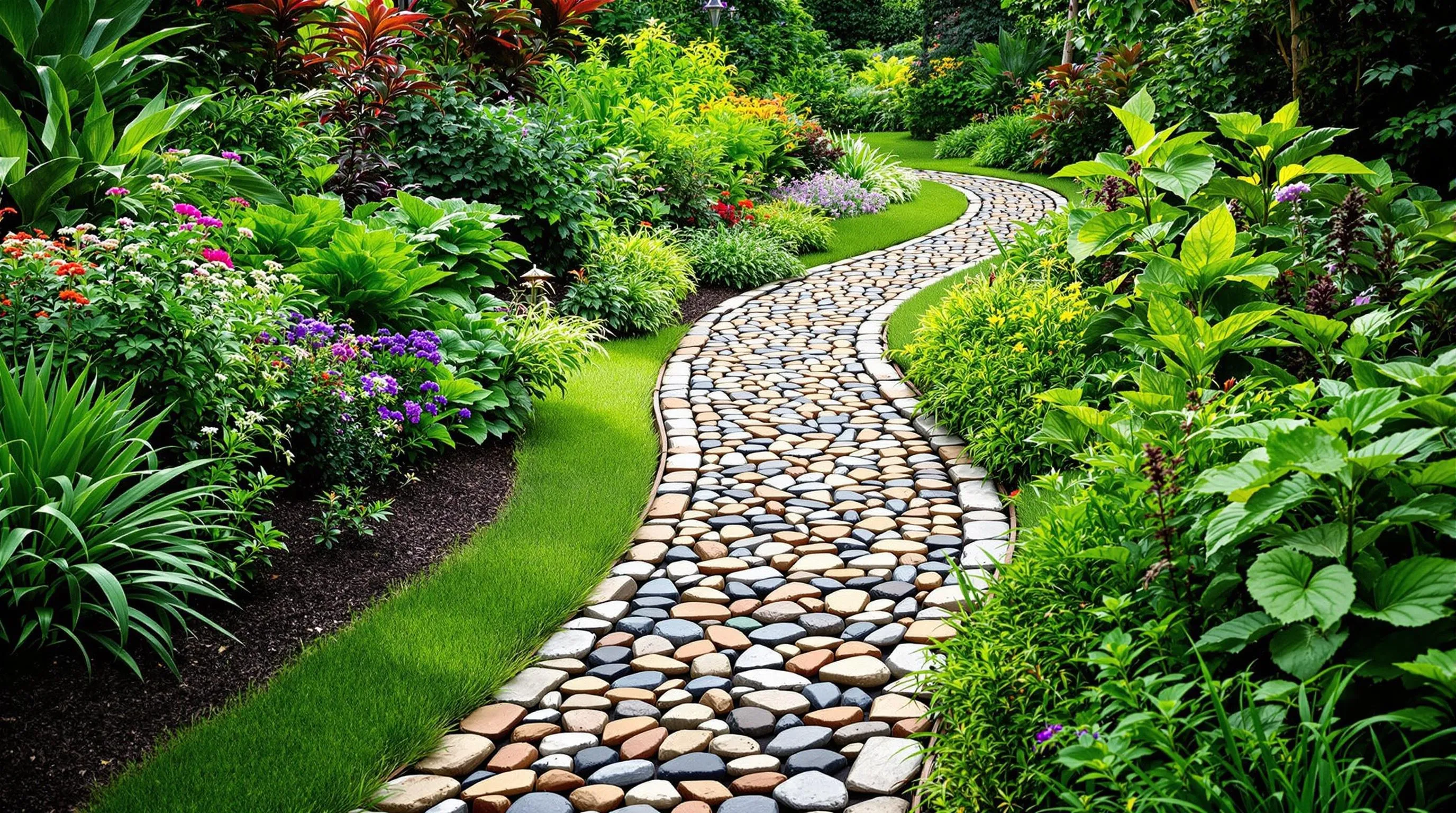
Pathways aren’t just functional elements in your vegetable garden—they’re opportunities to enhance its visual appeal while improving accessibility. Well-designed paths create structure, define growing areas, and make your garden more inviting and navigable.
Stone Mosaic Walkways That Define Garden Rooms
Stone mosaic walkways transform ordinary garden paths into artistic statements that naturally divide your vegetable garden into distinct “rooms.” Create these stunning paths using river rocks, slate pieces, or pebbles arranged in decorative patterns. For a truly personalized touch, incorporate mosaic designs with colored stones that complement your vegetables and herbs. These pathways not only provide stable footing during wet weather but also reduce mud splashing onto nearby plants during rainstorms. Position these stone walkways strategically to guide visitors through your garden’s highlights while clearly defining different growing zones. The natural texture and varied colors of stone mosaics add year-round visual interest, ensuring your garden remains attractive even during winter months when vegetable beds may be dormant.
Mulched Paths with Decorative Edging Materials
Mulched pathways offer a practical, budget-friendly solution that adds rustic charm to your vegetable garden. Line these paths with decorative edging materials like reclaimed brick, weathered wood, ornamental metal borders, or even repurposed wine bottles partially buried upside-down. These defined edges keep mulch contained while adding a polished look to your garden’s layout. Wood chip or straw mulch creates comfortable, weed-suppressing walkways that naturally decompose over time, gradually improving your soil. For added visual impact, consider alternating mulch types between garden sections or using colored mulch to create patterns that complement your planting scheme. The soft surface is gentle on your feet during long gardening sessions and provides excellent drainage during heavy rains, preventing pathway puddles that might otherwise slow your garden maintenance.
Installing Water Features Among Your Vegetables
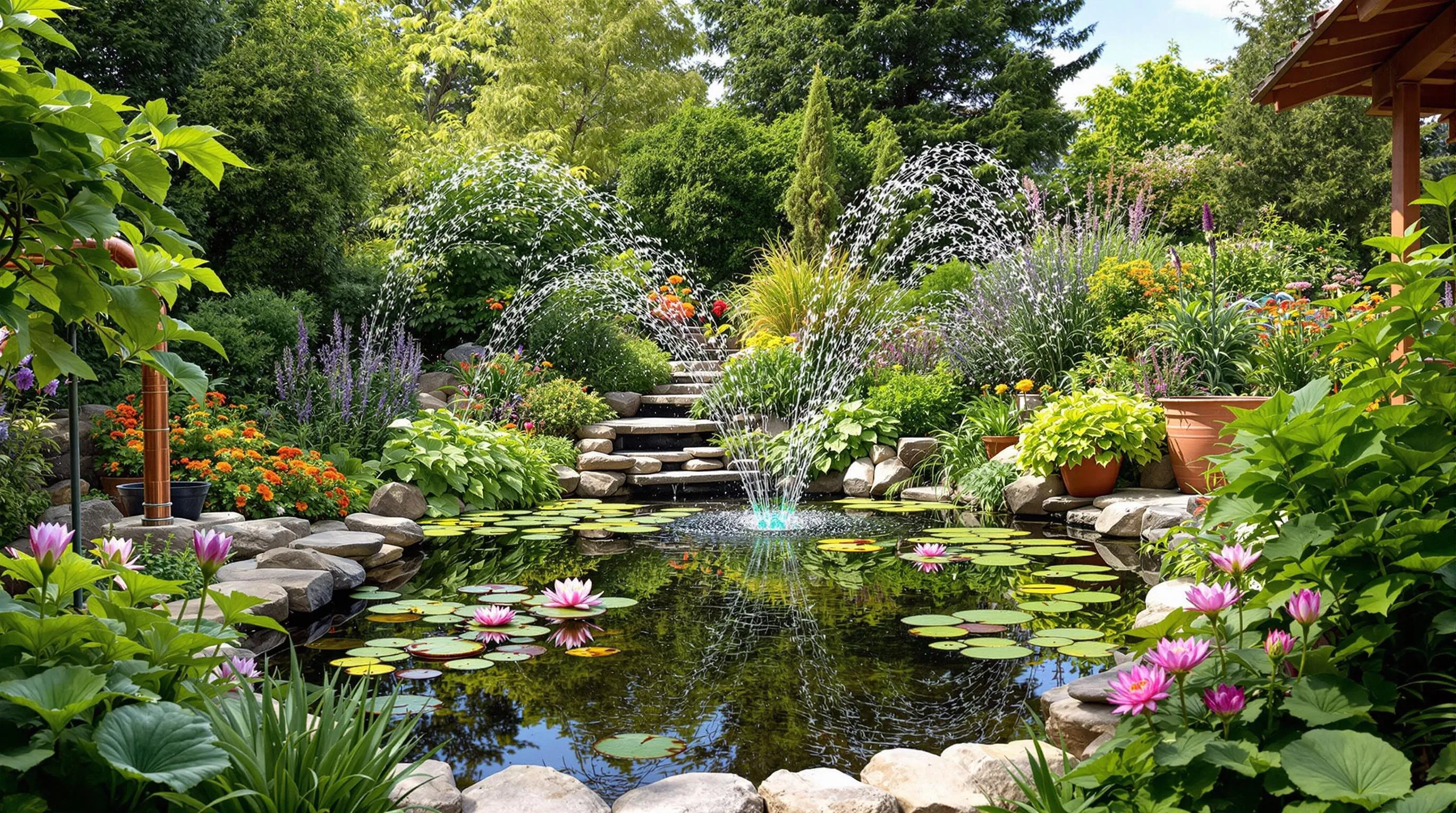
Water features can transform your vegetable garden from purely functional to visually stunning while providing important benefits for your plants and local network.
Mini Ponds That Attract Beneficial Wildlife
Mini ponds nestled among your vegetable beds create instant biodiversity hubs that benefit your garden. These small water features attract helpful pollinators like bees and butterflies, while also inviting natural predators such as frogs and dragonflies that feed on garden pests. To create a mini pond, repurpose items like galvanized tubs, ceramic pots, or even sealed wooden half-barrels. Position your pond where it receives partial sunlight (4-6 hours daily) to prevent excessive algae growth. Add water plants like miniature water lilies or water lettuce to maintain oxygen levels and provide habitat. For wildlife accessibility, create gentle slopes or “beaches” using stones of varying sizes that allow creatures to enter and exit safely. The soothing sound of water will enhance your garden experience while the reflective surface adds depth and visual interest between your vegetable rows.
Decorative Irrigation Systems as Garden Art
Transform necessary irrigation into decorative focal points by installing artistic watering answers that combine function with beauty. Copper pipe fountains create striking vertical elements while providing gentle water circulation that benefits nearby plants. Solar-powered water features eliminate the need for electrical connections while adding gentle movement and sound to your garden. Consider installing decorative rain chains that direct water from gutters into collection barrels adorned with mosaic tiles or painted designs. For an affordable option, create a recycled bottle drip irrigation system using colorful glass bottles positioned upside down in soil near thirsty plants. These functional art pieces slowly release water directly to roots while adding whimsical color throughout your beds. Decorative clay ollas (unglazed ceramic pots) buried among vegetables provide efficient irrigation while only their decorative tops remain visible, creating an ancient yet artistic watering method that reduces water usage by up to 70%.
Using Ornamental Containers for Vegetable Gardening
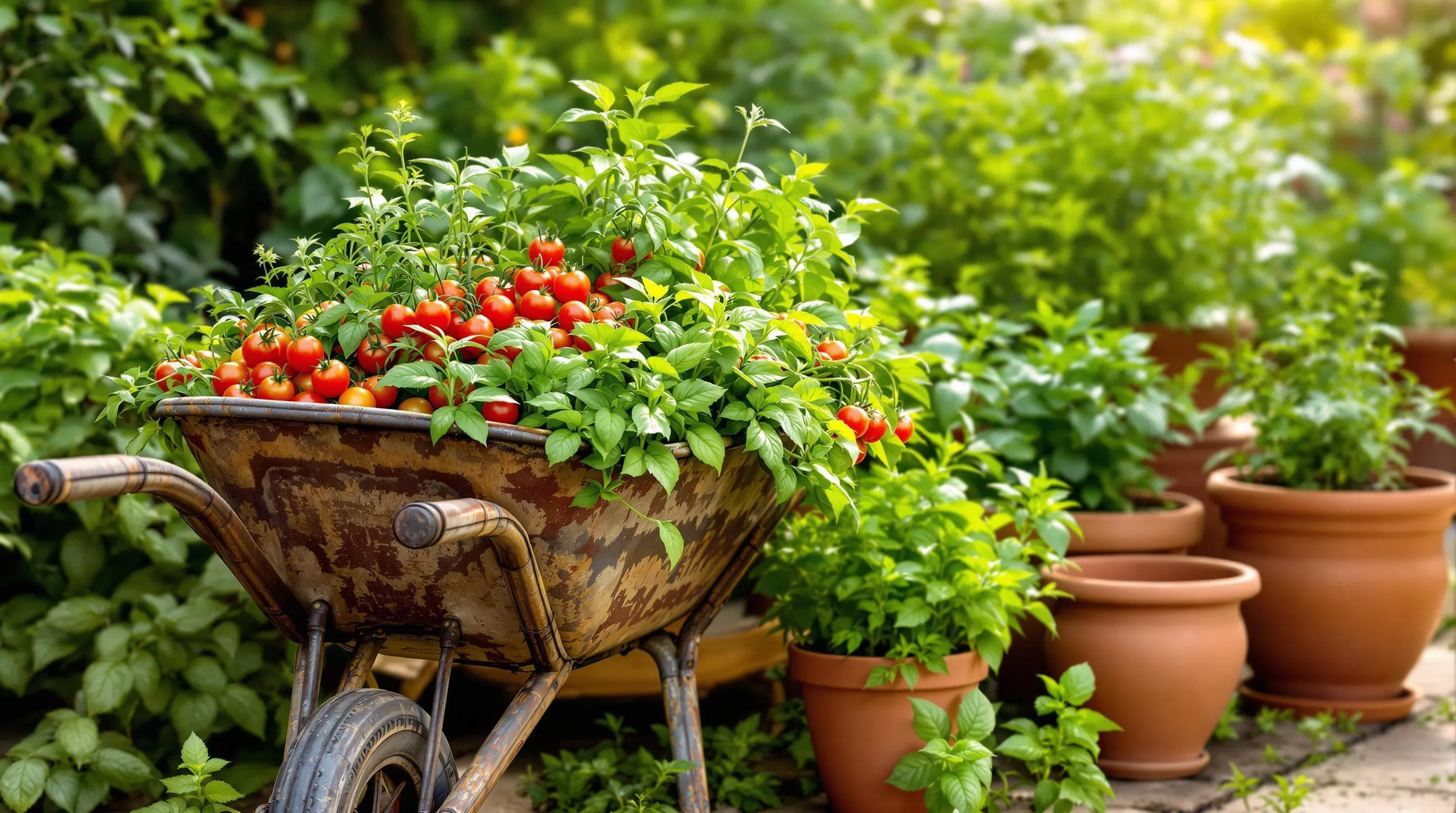
Container gardening offers a perfect blend of functionality and style for vegetable growers with limited space or those wanting to add decorative elements to their industry. Ornamental containers transform ordinary vegetable gardens into eye-catching displays while providing excellent growing conditions for your edible plants.
Vintage Wheelbarrows and Buckets as Planters
Repurposed vintage wheelbarrows create charming focal points in any garden space while providing ample room for growing vegetables. The rustic appeal of weathered metal or wooden wheelbarrows adds character and countryside charm to modern landscapes. Fill these mobile planters with compact vegetables like cherry tomatoes, lettuce varieties, and trailing herbs for a productive display. Old galvanized buckets, milk cans, and washtubs offer similar vintage appeal on a smaller scale. Drill drainage holes in the bottom, add quality potting soil, and group containers of varying heights for a visually interesting arrangement that maximizes growing space while showcasing your personal style.
Coordinated Pottery Collections for Herb Gardens
Create a cohesive and visually striking herb garden using coordinated pottery collections that complement your home’s exterior. Select containers with a unified color scheme or complementary patterns to establish a designer look. Terracotta pots in graduating sizes offer Mediterranean flair, while glazed ceramics in blues or earth tones create more dramatic displays. Position taller herbs like rosemary and sage in larger central containers, then surround them with smaller pots containing low-growing basil, thyme, and oregano. This arrangement not only enhances your outdoor aesthetic but also makes harvesting convenient for everyday cooking. Group containers on steps, patios, or dedicated plant stands to maximize vertical interest and ensure each herb receives proper sunlight.
Creating Theme Gardens That Tell a Story
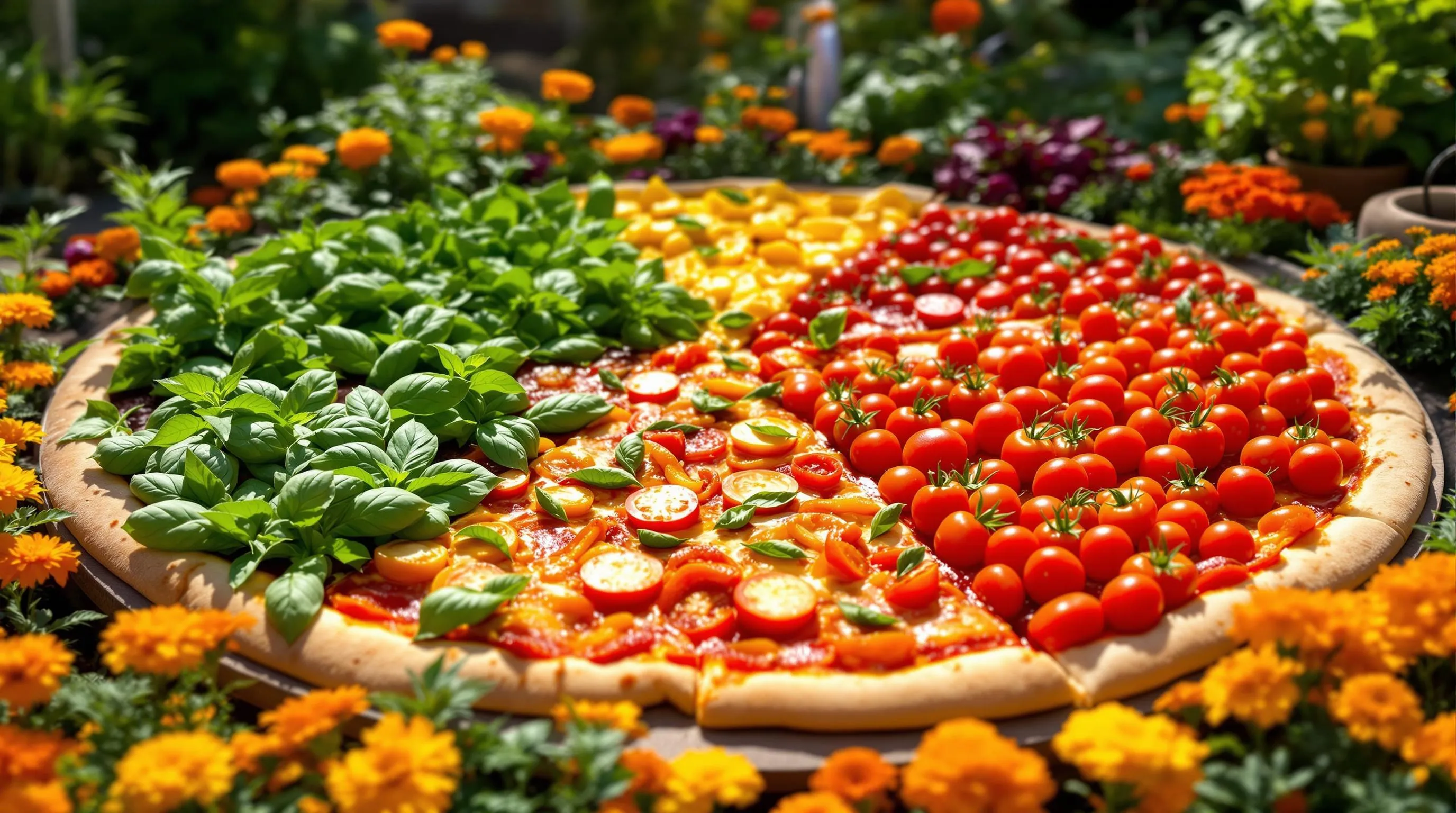
Theme gardens transform your vegetable patch into a meaningful growing space that reflects your interests and passions. By organizing plants around a central concept, you create a garden that’s not just productive but also tells a compelling story.
Pizza Gardens with All the Necessary Ingredients
Create your own pizza garden by planting all the essential ingredients in one dedicated space. Design this theme garden in a circular pattern divided into “slices,” with each section containing different pizza toppings. Plant roma tomatoes and San Marzano varieties in the center, surrounded by sections of oregano, basil, thyme, and rosemary. Add peppers, onions, and garlic in their own wedges. For visual appeal, edge the circle with marigolds or nasturtiums that mimic the golden crust of a perfectly baked pizza. This practical theme garden doesn’t just look charming—it delivers all your pizza ingredients within arm’s reach when it’s time to harvest and cook.
Global Cuisine Gardens with International Vegetables
Transform your garden into a culinary industry tour by dedicating different beds to vegetables from various global cuisines. Create a Mediterranean section with eggplants, tomatoes, zucchini, and herbs like oregano and basil. Establish an Asian-inspired plot featuring bok choy, Thai basil, lemongrass, and Chinese broccoli. Include a Mexican garden area with tomatillos, various peppers, cilantro, and epazote. Label each section with decorative signs identifying the cuisine type, adding both educational value and visual interest. This theme garden introduces you to new vegetables while creating a conversation starter for garden visitors. As a bonus, you’ll always have the perfect ingredients on hand for authentic international dishes.
Incorporating Artistic Elements and Garden Sculptures
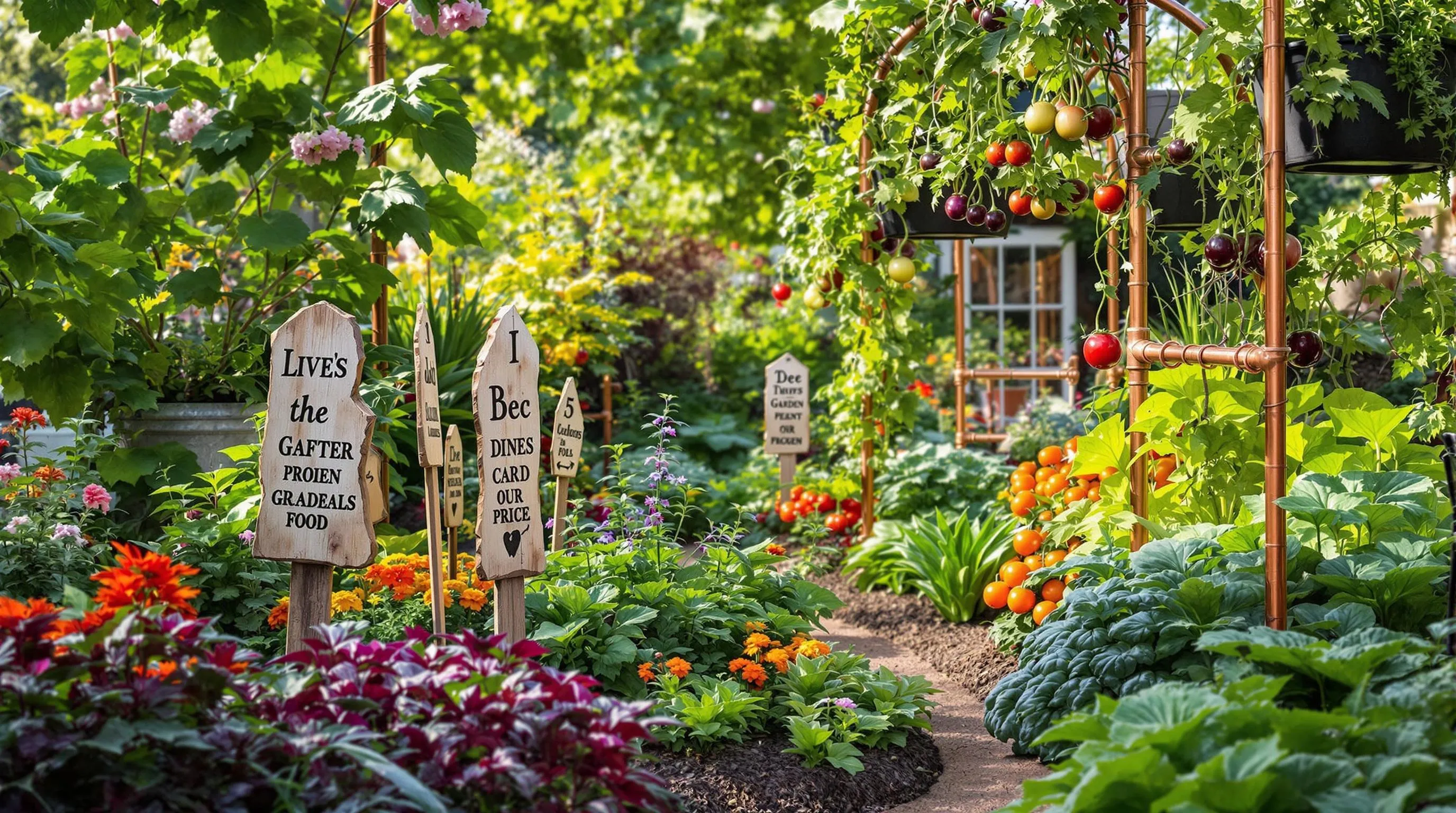
Transform your vegetable garden into an outdoor gallery by integrating artistic elements that enhance both form and function. Well-placed sculptures and decorative items create focal points that elevate your garden’s visual appeal while maintaining its productivity.
Handcrafted Plant Markers and Stakes
Personalized plant markers add both practicality and charm to your vegetable garden. Create custom wooden stakes with pyrography (wood burning) to identify different varieties while adding rustic appeal. Painted stone markers offer weather-resistant durability and become mini art pieces nestled between your plants. For an eco-friendly option, repurpose wine corks attached to skewers and label them with permanent markers. Metal plant markers crafted from repurposed silverware can be stamped with vegetable names and bent into decorative shapes that catch sunlight. Position these artistic identifiers throughout your garden beds to combine utility with unexpected moments of delight that reflect your personal style.
Trellises and Supports as Sculptural Elements
Elevate necessary supports into eye-catching sculptural features by selecting materials and designs that complement your garden aesthetic. Copper pipe trellises develop a beautiful patina over time while providing sturdy support for climbing vegetables like cucumbers and beans. Wrought iron arbors create dramatic entrances between garden sections and offer vertical growing space for flowering vines like scarlet runner beans. Woven willow structures bring organic texture and can be shaped into domes, pyramids, or curved walls that double as living sculptures when covered with climbing plants. Repurposed items like vintage ladders, bicycle wheels, or metal headboards transform into conversation-piece supports that blend nostalgia with functionality. Position these sculptural supports strategically as focal points that draw the eye through your garden while maximizing growing space.
Transforming Your Harvest Area into a Garden Feature
Your vegetable garden deserves to be a showcase rather than an afterthought. By implementing these decorative vegetable garden ideas you’ll create a space that nourishes both body and soul.
Remember that functionality and beauty aren’t mutually exclusive in the garden. Whether you’re drawn to geometric patterns potager designs or artistic containers your edible industry can become the most admired feature of your property.
Start small by incorporating just one or two ideas that resonate with your style and space. As your confidence grows you can expand your creative vision. The most beautiful vegetable gardens evolve over time reflecting both practical needs and personal expression.
Happy gardening as you transform your harvest area into a true garden masterpiece!





